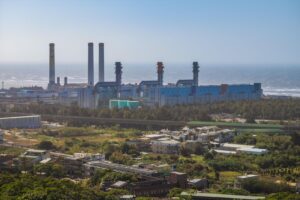
Guest post: Why all fossil fuels must decline rapidly to stay below 1.5C
Multiple Authors
10.26.23With 151 countries, 257 cities and 969 companies havingannouncednet-zero targets, it is clear that much of society now understands the need to achieve net-zero carbon dioxide (CO2) emissions by mid-century in order to limit dangerous warming.
However, there is less agreement on the actions required to get there.
Since theCOP26UN climate summit in 2021 agreed to a “phasedown of unabated coal”, a growing group of nations have been pushing for a“phase out” of all fossil fuels.
So far, consensus on this remains elusive.
In ournew studypublished in Nature Communications, we explore what the mitigation scenarios compiled in theIntergovernmental Panel on Climate Change(IPCC)sixth assessment report(AR6) say about phasing out fossil fuels.
We found that, across all scenarios, global coal, oil and gas supply must decline by an average of 95%, 62% and 42%, respectively, from 2020 to 2050 in order to limit long-term warming to 1.5C with no or limited “overshoot“.
While there is relative consensus in these pathways about the pace of decline needed for coal and oil, the long-term role of gas is highly variable.
We found that scenarios with more gas were reliant on potentially unachievable levels of carbon capture and storage (CCS) andcarbon dioxide removal(CDR) .
If CDR is limited to levels judged plausible by experts, then gas supply must fall twice as quickly to 2050 – by 84% rather than 42% – in order to limit warming to 1.5C. Rates of reduction for coal and oil also increase to 99% and 70%, respectively.
Overall, our research points to the need to rapidly cut the supply and demand of all fossil fuels – coal, oil and gas – if the world is to avoid dangerous warming.
Global fossil fuel reduction pathways
The last two annual UN climate summits saw governmentsfailing to agreeto the phase out of all fossil fuels.
In response to this year’s “global stocktake” – anassessmentof whether countries are on track to achieve the Paris Agreement’s goals – some governments and civil society have put forwardoptionsincluding calls to end fossil fuel exploration well ahead of 2030 and to phase out fossil fuel production by 2050.
To help inform these ongoing debates, we analysed the hundreds ofmitigation scenariosthat were assembled in the latest IPCC report. We explored what they say about the speed and feasibility of different fossil fuel reduction pathways in line with keeping warming below 1.5C above pre-industrial temperatures.
The starting point for our work was the 94 scenarios assessed by the IPCC to limit warming to 1.5C with no or limited overshoot, known as “C1” pathways. The majority of these scenarios suggest substantial reductions in coal and oil supply – whether for energy or non-energy uses – between now and mid-century, as shown by the left and centre panels in the figure below.
然而,他们表现出更少的缺点ensus around the role of gas, with some scenarios seeing an almost complete phaseout by around 2050, while others see continued or even increasing supply out to 2100 (right panel).
Across all 94 scenarios, the central reductions in global coal, oil, and gas between 2020 and 2050 are 95%, 62% and 42%, respectively.

Our next step was to dig into why the gas pathways differ so widely among the C1 scenarios. To do this, we looked at a range of other variables in these 1.5C pathways to see what else is needed in scenarios with higher or lower gas use this century.
As can be seen in the top left panel in the figure below, three typologies of global gas pathways can be identified:
- 1. “Fast decline” pathways showing rapid reductions between now and around mid-century (dark blue line).
- 2. “Slow decline” pathways showing relatively more gradual reductions (mid blue).
- 3. “Rebound” higher-gas pathways showing a near-term decline followed by an increase after around mid-century (light blue).

We found that the modelled gas pathways are largely influenced by three factors, which can also interact with one another and which primarily vary by model family and scenario design.
These factors are carbon pricing, constraints on the availability of CCS and CDR, and constraints on renewable energy deployment.
(我们注意到CCS可以耦合到化石燃料e, bioenergy use, or direct air capture; the latter two constitutenovel CDRmethods. Conventional CDR relies on land-based measures, such as afforestation and reforestation.)
For example, the “REMIND” model family has some of the highest carbon prices, imposes the most stringent assumptions on the global and regional CO2 storage potential and injection rate, and assumes some of the lowestlevelised costsof electricity from wind and solar compared to other models. Consequently, all but one C1 scenario from REMIND are grouped into the “fast decline” and “slow decline” clusters.
Conversely, many C1 scenarios generated by the “MESSAGE”, “GEM-E3”, and “WITCH” model families display the “rebound” pattern.
These models typically place no or relatively less stringent constraints on CO2 storage potential and injection rates. Moreover, many of the scenarios from these models are generated under a particular designprotocol, in which carbon prices initially increase, but then stabilise or decrease after net-zero CO2 emissions are reached around mid-century and mitigation efforts are relaxed.
Given real-world evidence that the phase-out and phase-in of technology systems are typically highly path-dependent, we argue in our paper that gas-rebound pathways require a more careful evaluation of underlying modelling assumptions, specifically in relation to CCS.
Keeping 1.5C in reach
As a next step, we looked at how the decline of coal, oil and gas would be affected, if 1.5C pathways are restricted to reflect likely real-world constraints on the availability of CCS and CDR.
In 2020, researchersconducteda survey to ask experts to estimate the likely “feasible potential” of three CDR methods, given technical factors such as geological CO2 storage capacity, as well as non-technical factors, such as sustainability considerations and governance constraints.
As the figure below shows, if CDR is limited to what experts think is reasonably achievable, then staying below 1.5C would mean that global production and use of gas would have to be cut twice as fast, to 84% below 2020 levels by 2050 (dashed blue line in the right-hand panel), rather than the 42% implied by the full set of C1 pathways (solid blue line). The corresponding cuts for coal and oil become 99% and 70%, respectively.

Our analysis finds scenarios with long-term high reliance on gas are contingent upon high levels of deployment of CCS and CDR.
Moreover, we show that such high dependence on CCS and CDR is most likely driven by inadequate model representation of real-world constraints on their potential, as well as on energy system path dependencies.
Our findings show that when CCS and CDR are restricted to plausible levels, gas use must also decline rapidly if warming is to be limited to 1.5C, along with coal and oil. This suggests thatnarrativesaround gas as a “bridge”, “transition”, or “cleaner” fuel may be misplaced.
A climate mitigation strategy that entails a fossil fuel phase out with limited CCS and CDR reliance would alsobring aboutlocalised, near-term benefits from reduced air and water pollution, human rights violations, and biodiversity loss, among others.
To date, few governments and companies have been willing to acknowledge that, to limit warming to 1.5C, the production of all fossil fuels must also be reduced alongside other key climate actions, such as scaling up renewable energy, energy efficiency and electrification, as well as reducing methane emissions from all sources.
Our findings show that, to keep the 1.5C goal in reach, the production and use of gas – as well as coal and oil – will need to decline rapidly and substantially between now and 2050.





